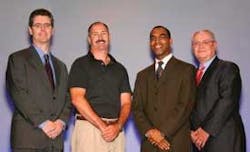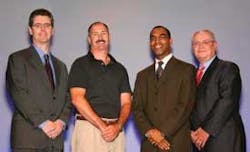FTTXcellence Award winner prepares for the future
by Stephen Hardy
Ron Troyer, plant manager at Union Communications in Farmington, NH, and recipient of the 2007 FTTXcellence Award, has spent the last 27 years in the military. Not surprisingly, his stint on active duty and his current role as a school sergeant major teaching communications technology skills in the Army Reserves has given him an appreciation for preparedness. That’s why he’s a believer in Union’s roll-out.Troyer’s role in Union’s fiber deployment was recognized this past October when he received the FTTXcellence Award during the keynote proceedings at the FTTH Conference in Orlando, FL. The award, co-sponsored by Corning Inc. and Lightwave, honors an individual who has made a significant contribution toward the use of optical technology in North American access networks. Troyer received a Steuben glass statue to symbolize his achievement; One Economy, a non-profit organization dedicated to bringing the benefits of broadband technology to low-income citizens, received a $7,500 contribution in Troyer’s name as well.
Independent telco Union operates five exchanges and provides voice and data services to homes and businesses in the rural New Hampshire towns of Alton, Barnstead, Center Barnstead, Gilmanton Iron Works, and New Durham, as well as parts of Farmington and Strafford. Its main competition comes from the local cable TV company, MetroCast Cablevision, which offers Internet services as well as video.
As is common now at many telephone companies, keeping up with the cable-TV Joneses meant that Troyer and the senior management at Union could envision a bandwidth race that could stretch a marathon distance. Unfortunately, the company found itself hobbled by its ADSL system. Purchased in 1999, the Cisco Systems gear is no longer supported by the manufacturer, which made long-term upgrades to the network problematic.
“Because the maximum bandwidth we can provide with our current platform is only 8 meg, I think that clearly wasn’t going to be enough,” Troyer explains. “Our choices would have been to purchase a whole new DSL platform or to look into fiber to the home. So that made the decision to go into fiber to the home a little bit easier.”
After weighing a PON approach versus an active Ethernet point-to-point architecture, Union decided about two years ago to deploy the latter. “[Active Ethernet] provides the most flexible bandwidth and it’s symmetrical bandwidth. And it offers, I think, the simpler architecture, offering the fewer unknowns going forward,” Troyer says. “And it’s very scalable; we can start at 100 megabits symmetrical and upgrade to a gig very easily and at not a lot of additional cost.”
Common wisdom suggests active Ethernet architectures involve significantly more initial cost than PONs. Troyer says Union didn’t necessarily find that to be the case. “When we went through that process, once we factored in the cost of all those splitters, we found that the PON solution was not greatly less expensive,” he explains. “The biggest questions or issues that most PON providers get posed is where to put the splitters. And the ones that I’ve discussed it with say, for the greatest flexibility, place those splitters in the CO. Well, by doing that, it gives you the flexibility, but at the same time it takes away one of the largest reasons to go PON, and that’s to save the cost of rolling that large fiber count out of your CO. If you’re going to place those splitters in the CO, there’s no cost savings in fiber.”
Union has turned to Pannaway Technologies (www.pannaway.com) and Allied Telesis (www.alliedtelesis.com) to supply the FTTH system electronics, both for the central office and customer premises. Troyer says that at the time of equipment selection, these companies were the only two that had equipment certified to work with the SIP packet gateway interface of the Nortel DMS-10 platforms the telco already had in place. While Troyer’s crews have installed equipment from both vendors during the initial stages of the roll-out, he envisions moving to a single vendor after he has a chance to evaluate the two systems in the field.
The Union team has extensive experience with fiber, having used it to connect exchanges. Thus, Troyer says that getting his crews up to speed for the FTTH roll-out hasn’t proved difficult; in fact, they’re using test equipment the telco already possessed. Most of the technicians receive their FTTH training in-house, supplemented on occasion with courses provided by the Telephone Association of New England (www.tane.org). Troyer’s crews are laying fiber from Corning Cable Systems’ Evolant line supplied by EMBARQ Logistics (www.embarqlogistics.com).
The deployment plan is straightforward. “We’re running a single strand of fiber from each of our major remotes and central offices out to every subscriber,” says Troyer. “So really it’s fairly simplistic, in that anywhere that we currently have copper, we’re overbuilding with fiber. So we’re matching our copper network, almost, with one fiber per copper pair.”
The telco has installed fiber in two exchanges over the past two years; Troyer expects this deployment pace will continue. And while Union hasn’t introduced new services over the infrastructure yet, Troyer believes customers have already seen a difference.
“We’re noticing on the fiber installs, even though the pipe is the same size, there’s a higher amount of throughput, which equals better performance for the customer,” he says. “I believe the biggest initial improvement will be the reliability and the performance of the fiber because it’s not subject to noise and all of the interferers that the DSL network is subject to-the distances and the poor grounding and the quality of some of the copper lines.”
Troyer expects that Union will maintain its current Internet and voice offerings, at least in the short term. These include a variety of data services for both residential and business customers. Residential connection packages start at 2 Mbits/sec downstream; the standard residential downstream rate is 6 Mbits/sec. Both packages feature 864 kbits/sec upstream. Business customers can enjoy symmetrical 2- and 4-Mbit/sec services, as well as an asymmetrical offering of 6 Mbits/sec downstream and 864 kbits/sec upstream.
“I could easily see where you would have a 30-Mbit connection to the Internet in the relatively near future as people begin to stream more video off the Internet and begin to watch more video content from the Internet. There’s a lot of programming available now,” Troyer comments.
The potential the Internet holds for changing video viewing habits has Troyer leery about adding a video offering to Union Communications’ menu.
There are a lot of people who would argue that within five years you won’t need a video headend; you can get all the content you need off the Internet if you have a large enough pipe. That may in fact wind up being true,” he says. “Right now, the model for video for telephone companies is still very difficult to crack. Until enough telephone companies get involved in video to make an even playing field and bring down the cost of content, it’s a challenge to make that model work.”
Troyer also has plans to keep up with the potential of his network to support other services, from home security to video conferencing. “It’s such a wide open future. A lot of people spend a fair amount of time predicting what’s going to happen and theorizing on all the applications-from the ultrahigh-definition video and the 3D video conferencing to the home security applications. There’s almost a limitless list of things you could do with a good enough connection.
“How many of those become a profitable market or business model or application remains to be seen,” he concludes. “I think for us, it’s a matter of positioning the company so that when these things are developed we can take advantage of the fact that we can provide the bandwidth and the infrastructure required to support them.”
And thanks to its FTTH deployment plans, Union Communications will be ready for whatever the future may bring.


